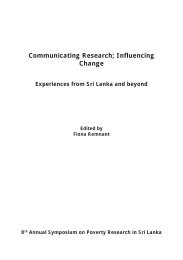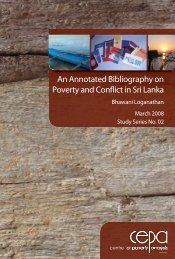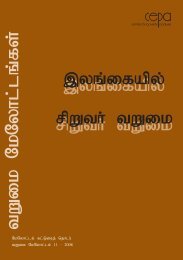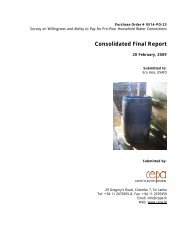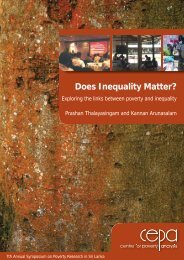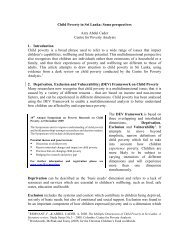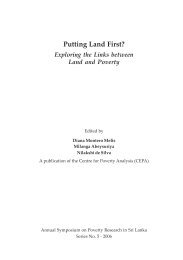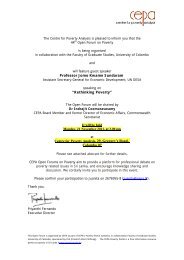Involuntary Displacement and Resettlement â Policy and ... - CEPA
Involuntary Displacement and Resettlement â Policy and ... - CEPA
Involuntary Displacement and Resettlement â Policy and ... - CEPA
- No tags were found...
You also want an ePaper? Increase the reach of your titles
YUMPU automatically turns print PDFs into web optimized ePapers that Google loves.
To complicate their lives even more, they needed to do this most likely in asituation where they had lost all their belonging including their homes, wereliving in a crowded, unfamiliar place without privacy (transitional shelter siteor camp), grieving for lost loved ones, <strong>and</strong> trying to make sense of thedestruction around them.Two studies conducted within the first year following the tsunami found thatin the majority of cases, relief assistance was not channelled to widows/widowers,but to their children, regardless of the children’s ages (Jayaweera 2005;Goonesekere 2006). This increased dependence of these single parents ontheir children as well as their vulnerability over the long term, having toconstantly rely on their children for their well-being <strong>and</strong> protection. In fact,Jayaweera (2005) found that 50% of the widows she interviewed had noincome of their own <strong>and</strong> were completely dependent on their children.Widows who were not dependent on children relied on government supportor other forms of private tsunami relief. When single heads, divorcees orwidows are dependent on others within the family (either children orin-laws), they can be subject not only to ill treatment (Thiruch<strong>and</strong>ran, 1999)<strong>and</strong> resented as an economic burden (Ruwanpura, 2006), but also can bedispossessed of their belongings by government officials or family membersthrough trickery (Young 2006: 202). Single heads should be able to obtainrelief <strong>and</strong> other forms of government compensation as individuals in theirown right.In this section, I explore some ground realities of post-tsunami reconstruction,specifically the moving out of transitional shelter <strong>and</strong> into permanent homesfor groups considered ‘vulnerable’. This section is part of a larger project onprocesses <strong>and</strong> practices of social exclusion in Sri Lanka. Examining howsingle-headed households, female-headed households, <strong>and</strong> the poornegotiate their way through the process of post-tsunami compensationprovides an opportunity to investigate how compensation <strong>and</strong> resettlementprogrammes can either reproduce structures <strong>and</strong> processes of socialexclusion or provide opportunities for social change. Theoretically I rely onTimothy Mitchell (1991) <strong>and</strong> Philip Abrams (1988) to investigate theactualities of social exclusion <strong>and</strong> how social exclusion is embedded withinpolitical processes. The laws governing post-tsunami compensation can beseen as a set of practices that act as “institutionalized mechanisms throughwhich a social <strong>and</strong> political order is maintained” (Mitchell, 1991: 74) <strong>and</strong> assuch are the processes that result in social subordination or exclusion(Abrams, 1988).179



